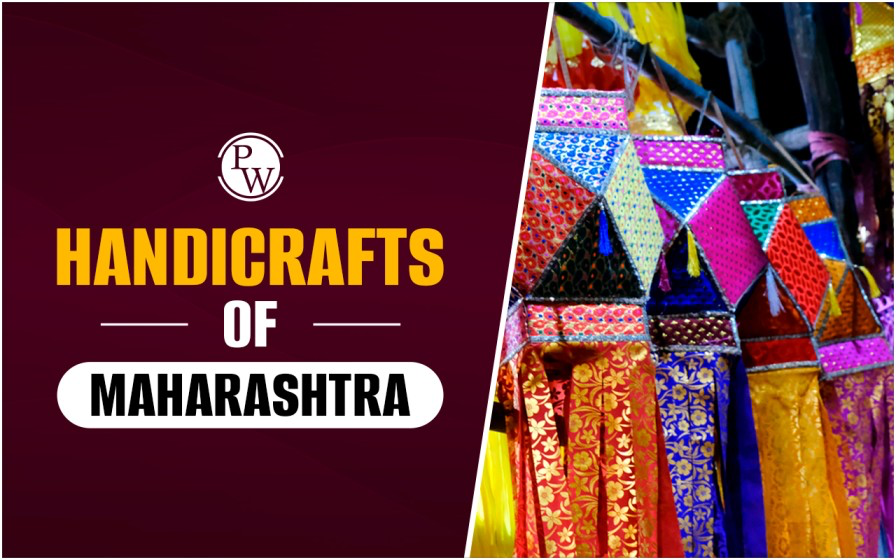
Handicrafts Of Maharashtra: An essential component of Maharashtra's cultural legacy are its handicrafts. Maharashtra crafts require exceptional talent and etiquette. It has many different forms, patterns, and designs, among other things. There are numerous talented craftspeople in the state. They use age-old methods to create a wide range of crafts.
Also read: Horticulture in Maharashtra
There are numerous communities of artisans in Maharashtra. Their areas of expertise are many types of handicrafts. With a blend of several cultures, the handicrafts are unique and varied. Maharashtra's culture reflects the blending of several ethnic groups. One characteristic that embodies the essence of the state is the art and craft of Maharashtra. It also honours the customs of the local people.
Here is the list of top famous handicrafts of Maharashtra:
The city of Aurangabad is the source of the Bidriware handicrafts. The word "Bidrwar" itself refers to a combination of zinc and copper metals. It is a combination of brass and silver. It is a well-known piece of brass or silver. This kind of craftsmanship has long been practiced by the Maharashtra people. Even the Mughals patronised it. Swords and other royal weapons were adorned with this art in the past. Later on, this style extended to everyday domestic objects. Plates, bowls, vases, ashtrays, jewellery boxes, glass, and bangles are examples of Maharashtra's bidriware handicrafts.
Also read: GI tag in Maharashtra
The rich arts and crafts of Maharashtra may be found in the city of Kolhapur. The renowned Kolhapuri chappals and jewellery collections from Kolhapur are well-known. These sandals or chappals are made of handcrafted leather. Both domestic and foreign markets have a high demand for Kolhapuri chappals. Kolhapuri Chappals have been around since the 12th century. King Bijjala and his minister Basavanna promoted the production of Kolhapuri Chappal. Supporting local cobblers was their goal.
Maharashtra's handicrafts are made at Sindhudurg and Ratnagiri. A particular group of people known as "Chittorees" engaged in the production of handicrafts made of lacquerware. They resemble the crafts of the Sawantwadi.
Sawantwadi is located in the Sindhudurg district. Its lacquerware is well-known. Sawantwadi Crafts is the name given to them. The 18th century saw an increase in the popularity of this art form. Its main objective was to educate Sawantwadi crafts. Sawantwadi crafts are created in great quantities, and the demand for the products is increasing. Among the handicrafts made from Sawantwadi lacquerware were dolls, chess sets, board games, and candle sticks.
Chitrakatha, Ganjifa, and Temple art are the three categories into which Sawantwadi crafts fall. Today, the Sawantwadi crafts are either private collections or exhibits in the museum. One of Maharashtra's most well-known handicrafts is the Sawantwadi.
Traditional jewellery has a long history in the state of Maharashtra. Precious stones and metals are used to make these. The following are a few varieties of Kolhapur jewellery handicrafts found in Maharashtra: Nath, Kolhapuri Saaj, Thushi, Bugdi, and Mundavalya, among others.
Also read: Tribes in Maharashtra
Traditional women wear Paithani Sarees, which are made of silk and come from the Paithan region. Because it is expertly created and composed of the finest silk, it is typically expensive.
The historical weaving styles of the old textile techniques known as Mashru and Himroo set them apart. Mashru is a fabric that combines cotton and silk to provide comfort and style. Mashru fabric is composed of cotton weft and silk warp, with cotton on the inside to add cosiness and softness and silk on the outside to define richness. Elegant garments like turbans, jackets, and sarees are made with it. The silk wrap exhibits rich colours and designs, while the cotton has a contrasting inner layer. Mashru fabrics are frequently brightly coloured.
India is familiar with the traditional Maharashtrian sarees, also called Narayan peth sarees. It is well known for its vivid colours, elaborate designs, and exquisite craftsmanship. To give it a shimmering, luxurious appearance with a variety of designs, it is woven using the Kadiyal technique using pure silk thread. Nature-inspired motifs like peacocks, florals, and other organic shapes are among them.
For Maharashtrian women, Nath is an important event that symbolises their marital status and wealth. This handicraft from Maharashtra comes in a variety of shapes and sizes. Wearing this classic nosepin, which comes in a big, round, or even crescent shape, with traditional Maharashtrian clothing enhances the women' elegance and attractiveness.
Crafted from gold and diamonds, it embodies the emotive elements that define tradition, femininity, and beauty in Maharashtra society.
Also read: Smallest District in Maharashtra
